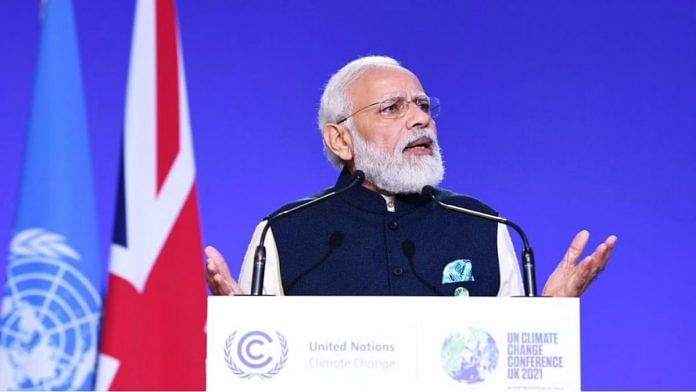On 20 October, Prime Minister Narendra Modi and UN Secretary-General Antonio Guterres launched Mission LiFE – Lifestyle for Environment. The mission aims to empower individuals to contribute toward mitigating climate change by becoming conscious of the environmental impact of their behaviour and consumption patterns. As India takes over the G20 presidency in December, LiFE offers a platform to promote individual-led demand-side interventions on the international stage.
This is a timely initiative because the transformations needed for deep greenhouse gas (GHG) cuts will require significant attention to lifestyle and consumption patterns, which in turn will balance the current emphasis on the production side of emissions. This idea is also well rooted in academic climate change literature. As per the Intergovernmental Panel on Climate Change (IPCC), demand-side actions have the potential to cut greenhouse gas emissions by at least 40-70 per cent in 2050.
People have to be motivated to change, which is why exhortation and building impetus for behavioural change is an important first step. In addition, two complementary steps can help spur implementation: infrastructure and supportive policies. While appropriate infrastructure can enable individual behavioural change, appropriate supportive policies can incentivise behavioural change. The LiFE movement can be strengthened by building on the idea that behaviour, infrastructure and policy can reinforce each other to bring about transformational change.
The positive interlocking between these arenas is well illustrated by three examples.
Also read: Adaptation too slow, COP27 must address loss and damage caused by climate change, says UN
Rethinking urban design
First, sustainable lifestyle choices can be fostered and promoted through appropriate urban planning. Urban emissions are an outcome of well-defined infrastructural, technological and behavioural systems that— if inappropriate—can act as barriers to climate action. To achieve lower emissions while increasing livability, a coordinated push to develop low-carbon urban design is needed. Some of India’s oldest cities, like Shahjahanabad built in the 17th century, offer lessons in the construction of mixed-use areas or areas that serve multiple purposes – one of the key tenets of urban emission reduction strategy. The concept of ‘superblocks’—intended to calm traffic in residential areas—implemented in Barcelona, Spain is another excellent example of how modifying urban design can lead to reduced vehicular emissions and pollution. LiFE could also feed into India’s Smart Cities Mission as it provides the ideal avenue for creating cities that provide economic opportunity while being sustainable and liveable.
Also read: What ‘sponge cities’ are and how they can help tackle flooding, climate change
Reducing transport emissions
Second, transport-linked behavioural changes are some of the most effective demand-side actions for reducing GHG emissions. People can be encouraged to make greener transport-linked lifestyle decisions in several ways. Designing a robust public transport system to encourage non-motorised transport is a key first step. The use of buses and metro rail networks offers significant emissions benefit over the use of private vehicles. While India is soon going to implement metro rail projects in 27 cities, Karnataka has drafted an active mobility bill, which seeks to protect the rights of pedestrians and cyclists. Moreover, electrification of road transport can help to make transport choices greener across the board.
The Faster Adoption and Manufacturing of (Hybrid &) Electric Vehicles in India (FAME) scheme has supported the purchase of over half a million EVs in the country. For the first time, EV sales have exceeded 10 per cent of vehicle sales in Delhi. Decarbonising freight transport could also be a crucial step. An efficient and clean logistics sector would make virtually every form of consumption marginally greener – a huge economy-wide benefit. Given the widespread electrification of the Indian railways, shifting India’s predominantly land-based diesel-powered freight to rail can help make goods transport even less carbon-intensive.
Also read: At COP27 summit, India to press rich countries to keep annual $100-bn climate fund pledge
Improving waste management
Third, shifting away from plastics and improving waste management practices can reduce both GHG emissions and plastic pollution, while giving rise to novel economic opportunities. The production of plastic is responsible for 4.5 per cent of global GHG emissions. Microplastics are adversely impacting the health of many living organisms, including humans. A shift from plastics would require reducing (and eventually stopping) their use while simultaneously substituting them with more environmentally friendly materials.
A big step in this direction was taken by the Indian government in August 2021, through a notification of the Plastic Waste Management Amendment Rules 2021, which prohibits certain single-use plastic products. This was timely, as a report by the Central Pollution Control Board (CPCB) found that per capita plastic waste generation in India nearly doubled in the five years from 2016 to 2022.
Today, natural alternatives such as sugarcane by-products are being used to produce tableware while cornstarch and jute are being used to produce carry bags. Further, waste reduction, reuse and recycling are all desirable lifestyle changes with GHG emissions mitigation potentials, which require building institutional and municipal capacity to manage and enforce waste segregation.
Mission LiFE seeks to decouple emissions from lifestyles. This is an essential element of addressing the climate crisis. We cannot hope to address climate change only through attention to how we produce—we also need to focus on how we consume and behave. To do so, attention to climate-friendly infrastructure and appropriate policy nudges can be important supportive elements of the behavioural revolution LiFE seeks to foster.
Navroz K. Dubash is a Professor and Annanya Mahajan and Arunesh Karkun are Senior Research Associates at the Centre for Policy Research. Views are personal.
(Edited by Zoya Bhatti)



